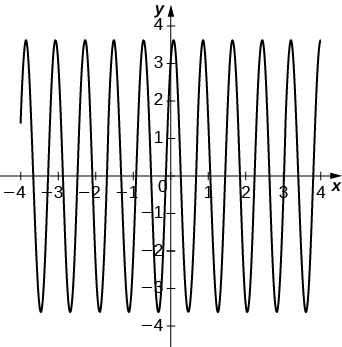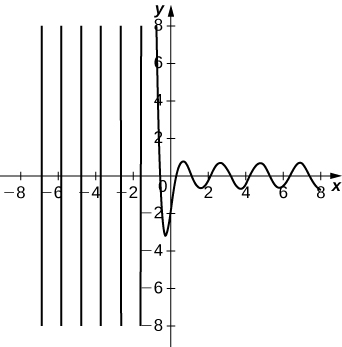17.1E: Exercises for Section 17.1
- Page ID
- 72449
In exercises 1 - 6, classify each of the following equations as linear or nonlinear. If the equation is linear, determine whether it is homogeneous or nonhomogeneous.
1. \(x^3y''+(x-1)y'-8y=0\)
- Answer
- linear, homogenous
2. \((1+y^2)y''+xy'-3y= \cos x\)
3. \(xy''+e^yy'=x\)
- Answer
- nonlinear
4. \(y''+ \dfrac{4}{x}y'-8xy=5x^2+1 \)
5. \(y''+( \sin x)y'-xy=4y \)
- Answer
- linear, homogenous
6. \(y''+\left(\dfrac{x+3}{y}\right)y'=0\)
In exercises 7 - 10, verify that the given function is a solution to the differential equation. Use a graphing utility to graph the particular solutions for several values of \(c_1\) and \(c_2.\) What do the solutions have in common?
7. [T] \(y''+2y'-3y=0; \quad y(x)=c_1e^x+c_2e^{-3x}\)
8. [T] \(x^2y''-2y-3x^2+1=0; \quad y(x)=c_1x^2+c_2x^{-1}+x^2 \ln(x)+ \frac{1}{2} \)
9. [T] \(y''+14y+49y=0; \quad y(x)=c_1e^{−7x}+c_2xe^{−7x}\)
10. [T] \(6y''−49y′+8y=0; \quad y(x)=c_1e^{x/6}+c_2e^{8x}\)
In exercises 11 - 30, find the general solution to the linear differential equation.
11. \(y''−3y′−10y=0\)
- Answer
- \(y = c_1e^{5x} + c_2e^{-2x}\)
12. \(y''−7y′+12y=0\)
13. \(y''+4y′+4y=0\)
- Answer
- \(y = c_1e^{-2x} + c_2xe^{-2x}\)
14. \(4y''−12y′+9y=0\)
15. \(2y''−3y′−5y=0\)
- Answer
- \(y = c_1e^{5x/2} + c_2e^{-x}\)
16. \(3y''−14y′+8y=0\)
17. \(y''+y′+y=0\)
- Answer
- \(y = e^{-x/2}\left(c_1\cos\frac{\sqrt{3}x}{2} + c_2\sin\frac{\sqrt{3}x}{2}\right)\)
18. \(5y''+2y′+4y=0\)
19. \(y''−121y=0\)
- Answer
- \(y = c_1e^{-11x} + c_2e^{11x}\)
20. \(8y''+14y′−15y=0\)
21. \(y''+81y=0\)
- Answer
- \(y = c_1\cos 9x + c_2\sin 9x\)
22. \(y''−y′+11y=0\)
23. \(2y''=0\)
- Answer
- \(y = c_1 + c_2x\)
24. \(y''−6y′+9y=0\)
25. \(3y''−2y′−7y=0\)
- Answer
- \(y = c_1e^{\left( (1+\sqrt{22})/3 \right)x} + c_2e^{\left( (1-\sqrt{22})/3 \right)x}\)
26. \(4y''−10y′=0\)
27. \(36\dfrac{d^2y}{dx^2}+12\dfrac{dy}{dx}+y=0\)
- Answer
- \(y = c_1e^{-x/6} + c_2xe^{-x/6}\)
28. \(25\dfrac{d^2y}{dx^2}−80\dfrac{dy}{dx}+64y=0\)
29. \(\dfrac{d^2y}{dx^2}−9\dfrac{dy}{dx}=0\)
- Answer
- \(y = c_1 + c_2e^{9x}\)
30. \(4\dfrac{d^2y}{dx^2}+8y=0\)
In exercises 31 - 38, solve the initial-value problem.
31. \(y''+5y′+6y=0, \quad y(0)=0,\; y′(0)=−2\)
- Answer
- \(y = -2e^{-2x} + 2e^{-3x}\)
32. \(y''+2y′−8y=0, \quad y(0)=5,\; y′(0)=4\)
33. \(y''+4y=0, \quad y(0)=3, \; y′(0)=10\)
- Answer
- \(y = 3\cos(2x) + 5\sin(2x)\)
34. \(y''−18y′+81y=0, \quad y(0)=1, \; y′(0)=5 \)
35. \(y''−y′−30y=0, \quad y(0)=1, \; y′(0)=−16\)
- Answer
- \(y = -e^{6x} + 2e^{-5x}\)
36. \(4y''+4y′−8y=0, \quad y(0)=2, \; y′(0)=1\)
37. \(25y''+10y′+y=0, \quad y(0)=2, \; y′(0)=1\)
- Answer
- \(y = 2e^{-x/5} + \frac{7}{5}xe^{-x/5}\)
38. \(y''+y=0, \quad y(π)=1, \; y′(π)=−5\)
In exercises 39 - 46, solve the boundary-value problem, if possible.
39. \(y''+y′−42y=0, \quad y(0)=0, \; y(1)=2\)
- Answer
- \(y = \left( \frac{2}{e^6 - e^{-7}} \right)e^{6x} - \left( \frac{2}{e^6 - e^{-7}} \right)e^{-7x}\)
40. \(9y''+y=0, \quad y(3π^2)=6, \; y(0)=−8\)
41. \(y''+10y′+34y=0, \quad y(0)=6, \; y(π)=2\)
- Answer
- No solutions exist.
42. \(y''+7y′−60y=0, \quad y(0)=4, \; y(2)=0\)
43. \(y''−4y′+4y=0, \quad y(0)=2, \; y(1)=−1\)
- Answer
- \(y = 2e^{2x} - \left( \frac{2e^{2}+1}{e^2} \right)xe^{2x}\)
44. \(y''−5y′=0, \quad y(0)=3, \; y(−1)=2\)
45. \(y''+9y=0, \quad y(0)=4, \; y(π^3)=−4\)
- Answer
- \(y = 4\cos 3x + c_2\sin 3x,\) infinitely many solutions
46. \(4y''+25y=0, \quad y(0)=2, \; y(2π)=−2\)
47. Find a differential equation with a general solution that is \(y=c_1e^{x/5}+c_2e^{−4x}.\)
- Answer
- \(5y'' +19y' -4y = 0\)
48. Find a differential equation with a general solution that is \(y=c_1e^{x}+c_2e^{−4x/3}.\)
For each differential equation in exercises 49 - 51:
- Solve the initial value problem.
- [T] Use a graphing utility to graph the particular solution.
49. \(y''+64y=0; \quad y(0)=3, \; y′(0)=16\)
- Answer
- a. \(y = 3\cos 8x + 2\sin 8x\)
b.

50. \(y''−2y′+10y=0; \quad y(0)=1, \; y′(0)=13\)
51. \(y''+5y′+15y=0; \quad y(0)=−2, \; y′(0)=7\)
- Answer
- a. \(y = e^{-5/2}\left[-2\cos\left(\frac{\sqrt{35}}{2}x\right) + \frac{4\sqrt{35}}{35}\sin\left(\frac{\sqrt{35}}{2}x\right) \right]\)
b.

52. (Principle of superposition) Prove that if \(y_1(x)\) and \(y_2(x)\) are solutions to a linear homogeneous differential equation, \(y''+p(x)y′+q(x)y=0,\) then the function \(y(x)=c_1y_1(x)+c_2y_2(x),\) where \(c_1\) and \(c_2\) are constants, is also a solution.
53. Prove that if \(a, \, b\) and \(c\) are positive constants, then all solutions to the second-order linear differential equation \(ay''+by′+cy=0\) approach zero as \(x→∞.\) (Hint: Consider three cases: two distinct roots, repeated real roots, and complex conjugate roots.)


